Eleutherai, Fortress of Eleutherai
The Archaeological site of Eleutherai (pronounced Elefthere, where -e- as in -bet-) is located by the Old National road Athens-Thebes (Athina-Thiva), right to the north of the junction to Villia. It contains part of a cultivated plain and a rocky hill on top of which the ancient fortress controls the narrow pass leading from Boeotia (Viotia) to Attica. From this point there is an unbroken view toward the ancient passage to the west and over the plain of Oinoe to the southeast. Tradition has it that the ancient city of Eleutherai was established by Dionysos, born himself there, thus given the name Dionysos Eleuthereus.
Its dating between 370 and 360 B.C. places it in the Athenian defence system that was evidently constructed along the borders of Attica during the 4th century B.C. More citadels forming this line of defense were Aigosthenion, Rhamnous and Phyle, together with watchtowers, signalling posts, temporary fieldworks and walled camps.
Select Page of the Album:
Click on any of the pictures to enlarge.
Eleutherai Ancient FortressThe line of the fortress at Eleutherai follows the lie of the hilltop, enclosing an area of 300 m x 100 m, with circuit walls 860 m in length. The vulnerable north side has a strongly constructed wall, preserved to a height of some 4 to 6 m., with two small sally - ports. It is reinforced by seven square towers, 6 m. along the side, that project from the two faces of the wall and are connected by a curtain wall with a parapet— walk. Two gateways provide entrance to the fortress: the main, double gateway is at the west above the control - road; the secondary entrance, at the southeast side, with a small gateway, connects the fortress with the city of Eleutherai by way of the south slopes of the hill. In addition to the norm side, the other sides too are reinforced, but with fewer towers - preserved only to a low level. Their masonry is in places polygonal and irregular, evidently because of the terrain.
Preserved in the interior, close to the north side, are the foundations of a building measuring 16 x 11 m., evidently with two storeys, with polygonal wall construction, a central passageway and a pair of rooms at each side. It is probably to be dated to a phase earlier than the fortress and it will have served as an installation facility for a garrison. It is possible too that it served for billeting even after the fortress was completed. Fragmentary low walls, scattered through the interior area of the fortress, indicate that there were other such buildings as well.
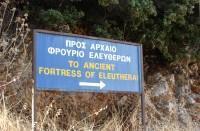
Eleutherai: This sign is found at the beginning of an uphill dirt road leading to the fortress
If you are venturing unguided, at least try to be accompanied by a local person who knows the way to the fortress because it can be easily missed. |
|

Eleutherai: Googgle Earth Photo to help visitors orient themselves
Google PrntScr of the Eleutherai archaeological site. The yellow pin marks the spot where the sign in the previous photo is to be found. It is exactly 1420 m (1553 yd) past the junction to Villia, on our way to Thiva. Coordinates of the yellow pin are: Latitude: 38° 10 min 54.60 sec N, Longitude: 23° 22min 13.26 sec E.
The uphill dirt road is discernible, dotted by us to be easily seen. The citadel is to the right and down, enclosed by a continuous purple line. The altitude of the almost level plateau where the fort was built is 470-490 m (1410-1470 ft).
(It might be useful to know that, having gone into the troube of coming all the way to here, one could pay a visit to another citadel nearby, belonging to the same defense line of Ancient Athenians, namely Aegosthenion. It is located 13 km (just over 8 miles)) from Villia, in the sea-side village of Porto Germeno.) |
|
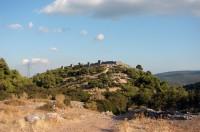
Eleutherai: The dirt road up to the citadel |
|
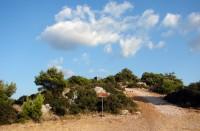
Eleutherai: Coming closer! Here we see the sign to the actual archaeological site |
|
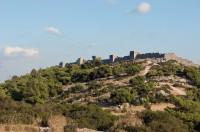
Eleutherai: Imposing view of the fort as we approach |
|
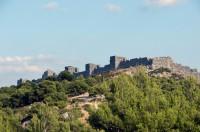
Eleutherai: Coming further up |
|
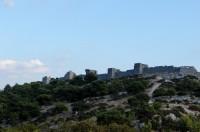
Eleutherai: Details are beginning to be discernible
More than twenty three centuries old, yet still standing! |
|
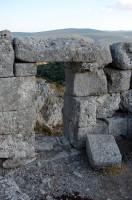
Eleutherai: A half-ruined back door |
|
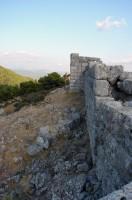
Eleutherai: The photo speaks for itself.
There have been no restoration works on this castle; mainly removal of vegetation which made the place almost unvisitable |
|
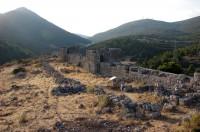
Eleutherai: Photo of the interior of the fortress
A rectangular white informative sign is seen in the middle of the photo. It contains a plan of the fortress, which is shown in the next shot. |
|

Eleutherai: Plan of the fortress included in the sign shown in the previous photo
Please compare with the introductory description of the castle |
|
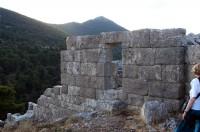
Eleutherai: The remnants of one of the towers |
|
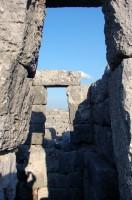
Eleutherai: The curtain wall with a parapet— walk uniting the towers |
|
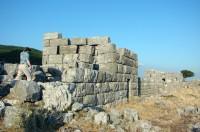
Eleutherai: One of the towers as seen from inside the Fort |
|
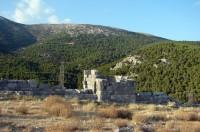
Eleutherai: Another one of these towers |
|
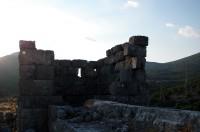
Eleutherai: Yet another one of the defensive towers |
|
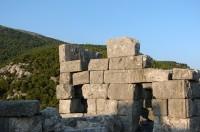
Eleutherai: Yet another one of the defensive towers, what is left of it, that is. |
|
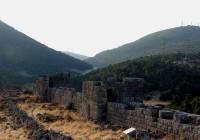
Eleutherai: Controlling of the narrow pass leading from Boiotia to Attica.
According to the intro text, the Fort was built at a strategic position for control of the narrow pass leading from Boiotia to Attica. From this point there is an unbroken view toward the ancient passage to the west. This photo shows the view over this narrow pass today. Imagine some of those pine-trees growing on the slope and blocking the view cut down, and the uninhibited view over the pass is a fact and proves our point. |
|

Eleutherai: Controlling of the narrow pass leading from Boiotia to Attica.
According to the same intro text, the Fort was built for control over also the plain of Oinoe to the southeast. This impressive panoramic photo shows the view over the plain of Oinoe. |
|
|
Select Page of the Album:
|
|



